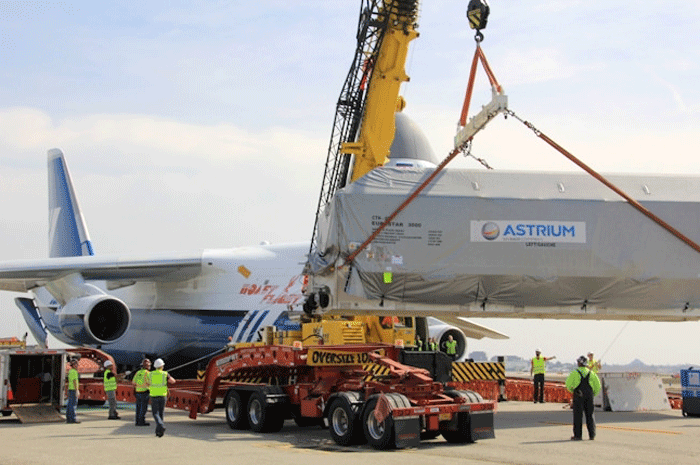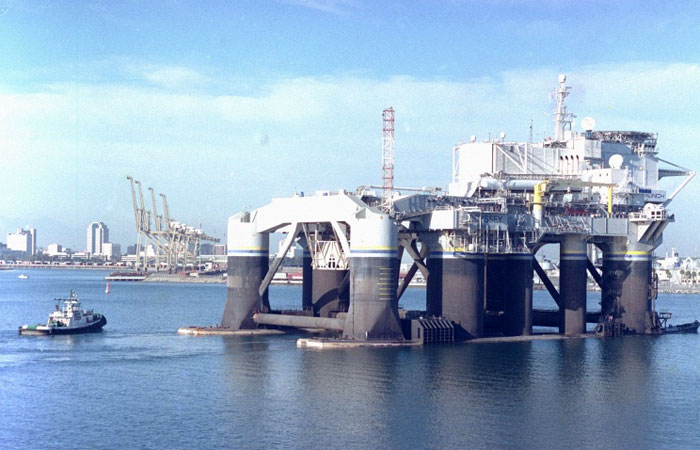.
20.02.2014












Nyon, Switzerland, 1 May, 2014 – Following suspension on 31 March of the launch campaign activities of the EUTELSAT 3B satellite, Sea Launch today announced that its prime contractor, Energia Logistics, Ltd., will this week restart testing in preparation for the rollout of the Payload Unit and its integration with the Zenit-3SL launch vehicle before departing to the launch site in mid-May.
The launch of the EUTELSAT 3B satellite is now scheduled for 26 May at 14:10 Pacific Daylight Time (21:10 UTC, 23:10 CEST) at the opening of a 54-minute launch window.
Based on the Eurostar E3000 platform of Airbus Defence and Space, the EUTELSAT 3B satellite has been designed to operate three commercial payloads in the C, Ku and Ka bands. This tri-band configuration will deliver exceptional levels of in-orbit flexibility and coverage from Eutelsat’s expanding 3° East neighourhood. The satellite will enable Eutelsat to diversify its commercial response to Internet Service Providers, telcos, government agencies and broadcasters operating in Latin America, Europe, Africa, the Middle East and Central Asia. EUTELSAT 3B has a designed in-orbit lifetime exceeding 15 years.

French satellite a chance for Sea Launch to return to successful orbit
After bankruptcy, president’s departure and failed launch, company looks to get back on track with Monday’s mission.
.

Sea Launch uses a modified oil rig to launch rockets near the equator.
.
The last time Sea Launch AG attempted to put a satellite into orbit, it ended quickly and badly.
The Zenit-3SL rocket blasted off from its oil rig roost in the middle of the Pacific Ocean near the equator on Jan. 31, 2013. But as 300 workers looked on, the rocket and its Boeing-made Intelsat 27 satellite dove less than 2½ miles from where it started. More than a million pounds of rocket, payload and hard work slammed into the water after 40 seconds of flight.
Sea Launch aims to get back on track Monday, when it is scheduled to launch a French telecommunications satellite. The Odyssey oil rig disembarked last week from the company’s 16-acre facility in Long Beach with the support freighter Sea Launch Commander, giving the ships plenty of time to make Monday’s blast-off point.
Success would mark the 36th completed mission for the company since 1999, and its first since December 2012. Sea Launch still is reeling from a 2009 bankruptcy in which Boeing relinquished a majority share. The ills continued this year with the departure of President Kjell Karlsen and the delay of Sea Launch’s latest mission.
“Their whole history has been one of challenges,” said Marco Caceres, senior space analyst for the aerospace and defense market research firm Teal Group Corp. “It’s a company that’s really a survivor. I’d never count them out.”
Sea Launch was established in 1995 as a consortium of four companies from Norway, Russia, Ukraine and the United States. Now, majority ownership belongs to Russia-based Energia Overseas Limited, and a senior executive team manages the company as Karlsen has yet to be replaced.
The company’s goal from the outset was to use smaller rockets but fire them from a converted oil rig in the Pacific, right around the equator. That’s closest to the satellites’ final destination, reducing mission costs and increasing payload capacity.
The satellite-launching business is littered with risk. Sea Launch’s January 2013 failure, the company’s third, puts it in good company.
Just down the road in Hawthorne, Space Exploration Technologies – better known as SpaceX – endured three failures before it tasted success, grabbing a piece of the coveted commercial satellite market and securing two NASA contracts.
Attaining that level of success will be much harder for Sea Launch, Caceres said. The company doesn’t command enough business, despite its competitive prices.
Sea Launch primarily sends satellites to geosynchronous orbit, a spot in the sky about 22,000 miles above the ground and directly over the equator. Telecom and defense satellites typically find homes in this orbit because ground antennae can maintain a fixed and clear signal at all times. The expense of the launches and the hardware make such missions relatively infrequent.
“As long as the market remains at about 20 launches a year, I can see them picking out one or two,” Caceres said. “If they can get to a point where they’re launching two or three a year, that will be a very good year for them.”
The commercial satellite launch field remains crowded with competitors SpaceX, Arianespace and International Launch Services. But Michael Blades, senior aerospace and defense industry analyst for market research firm Frost & Sullivan, said global fiscal belt-tightening could have long-term benefits for the private space launch companies.
“You have governments that are reducing their budgets, and they don’t want to subsidize space as much as they used to,” Blades said.


.
Update: 26.05.2014
.

.
Update: 27.05.2014
.

